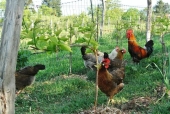posted 4 years ago
I'm not going to be much help to you because I just grew fodder for my chickens, so it was a small amount. I did mine outside on a rack. It was one of those craft racks with lots of shallow drawers. I got it at the thrift store for a couple of dollars because it didn't have any drawers. I put hard cloth in and used plastic rectangle trays that had a fine basket weave on the bottom, so water went through, but the seeds staid in the tray. I got them at the dollar tree. I would soak the seeds, then put them in the trays. I only watered once a day. I never used bleach, I would turn on the hose (I have well water so I don't have to worry about chlorine) with a sprinkler wand and water the top tray and that would water all the trays. I would move it around so the runoff water would water my walnut tree. I used wheat and barley. For me the wheat did better in the cooler seasons and the barley did better in the heat. The chickens liked the wheat better, but loved it all. The only trouble I had was keeping the seeds dark. They sprouted better when I would first put them in the tray if they were dark. I tried cotton towels, and dark screen, cardboard, probably other stuff. The cardboard was the worst because it didn't let the water through. The others worked great, but the sprouts would stick to what ever was in there. It wasn't a deal breaker, just a bit of an inconvenience. I think this problem could be solved by attaching a frame to the screen so it would sit on top instead of resting on the seeds. (don't know why I didn't think of that then, oh well) It was very easy. I didn't need nearly as much water as I saw on the internet. I watered once a day most of the time, and two time when it was very hot or windy. I live in N. California, so the summer months get very hot.
Most of this wont be that helpful to you because you need to go much larger scale. I just shared it with you so you understand how easy it is. It can be super simple and cheap, or it can be very complex, and quite pricey. You just need to do what you are comfortable with, and go for it. I don't actually grow fodder any more. I read fermenting grains is just as healthy for chickens, and even easier then growing fodder. You will need fodder for your cows of course, but you may consider fermenting grains for you chickens instead, or in addition to the fodder. It is super easy, very healthy, and they love it. What ever you do good luck, and have fun.
“We can complain because rose bushes have thorns, or rejoice because thorn bushes have roses.” — Abraham Lincoln







